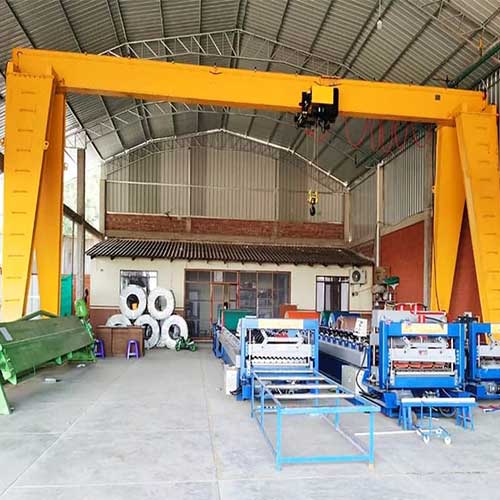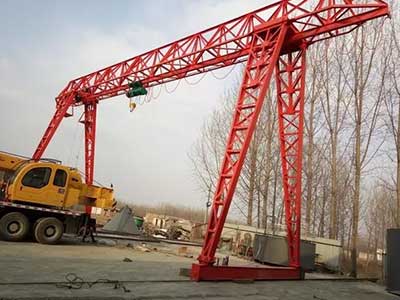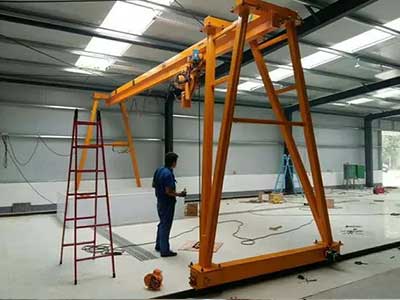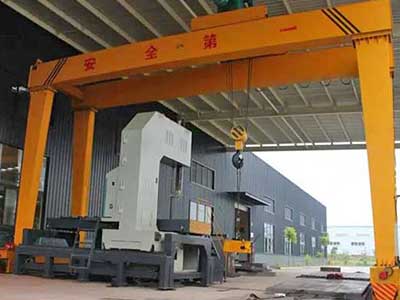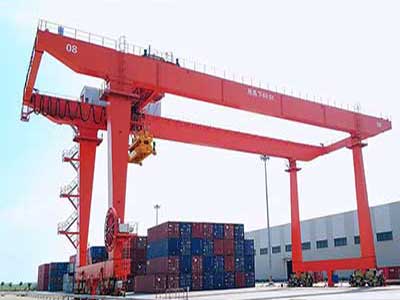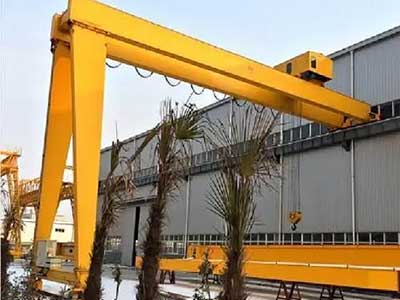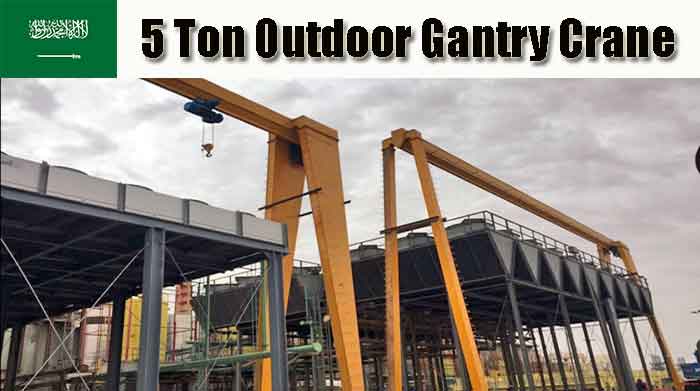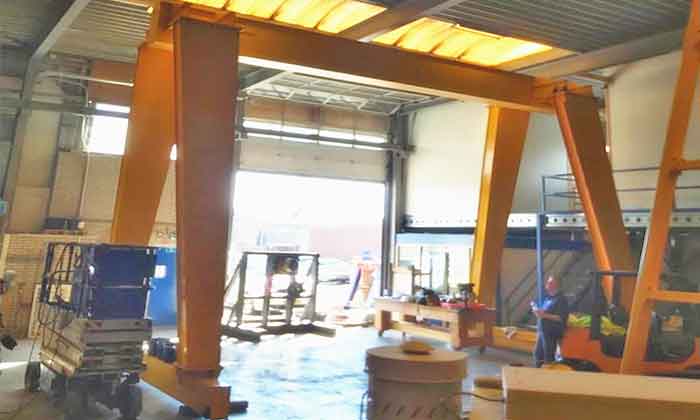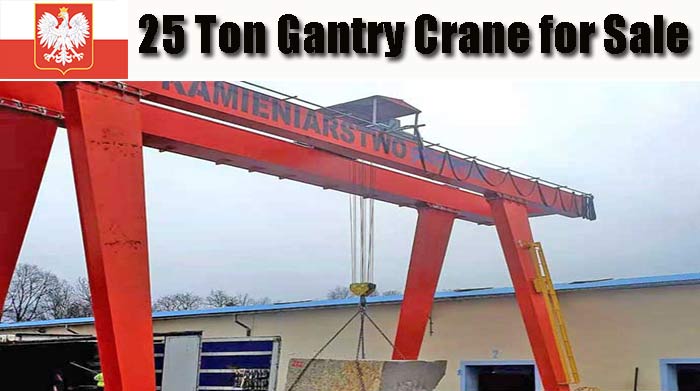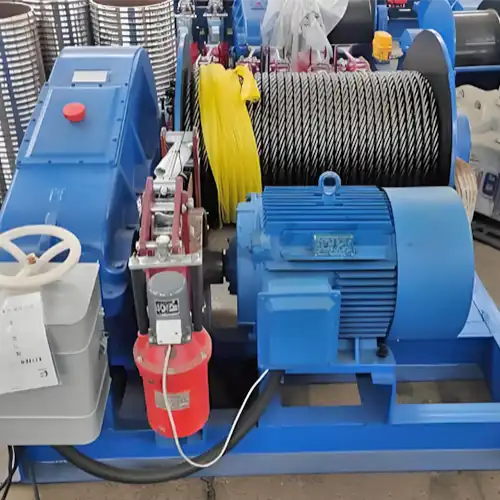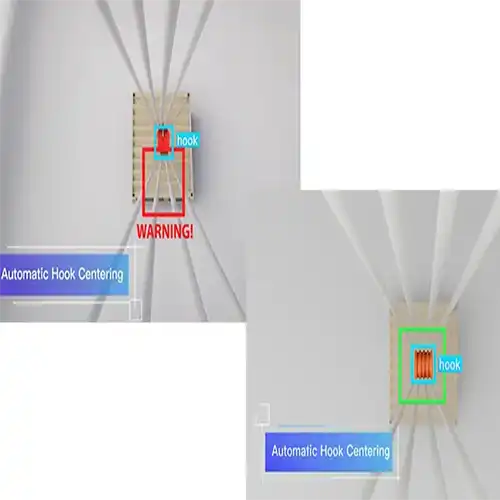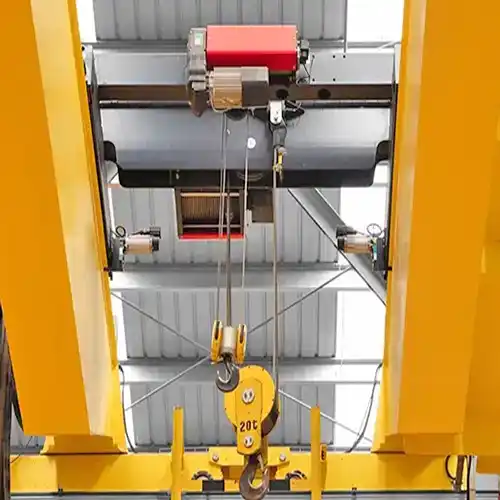1 Ton to 100 Ton Rail Gantry Cranes for Various Industrial Sectors
Rail gantry crane for sale. A comprehensive guide to all types of rail gantry cranes across industries to get your custom rail gantry crane design. Click!
Category: Crane on Rail
Your Trusted Crane on Rail Manufacturer & Supplier
1 Ton to 100 Ton Rail Gantry Cranes for Various Industrial Sectors
A Comprehensive Guide to Rail Gantry Cranes Across Industries
Rail gantry crane for sale. A comprehensive guide to all types of rail gantry cranes across industries to get your custom rail gantry crane design. Click!
In the realm of industrial material handling, the unsung hero that often carries the heavy load, quite literally, is the Rail Gantry Crane. This robust piece of machinery plays a pivotal role in streamlining operations across diverse industries, offering efficiency and precision in handling various loads. Let's embark on a journey to explore the world of rail gantry cranes, understanding their definition, purpose, and the profound significance they hold in the intricate dance of material handling across industries.
At its core, a rail gantry crane is a type of overhead crane that operates on a track or rail system, allowing horizontal movement of the crane along a defined path. These cranes typically come equipped with either single or double girders, providing structural support to the lifting mechanism.
The primary purpose of rail gantry cranes is to facilitate the movement and lifting of heavy or bulky loads within industrial settings. Unlike traditional cranes, the rail gantry crane is designed for versatility and efficiency. Its ability to traverse horizontally along a rail system ensures a larger operational area, making it an ideal choice for facilities with expansive workspaces.
Significance in Material Handling Across Industries
The significance of rail gantry cranes reverberates across a myriad of industries, from manufacturing and construction to logistics and shipping. Their ability to handle varying load capacities with precision makes them indispensable in scenarios where efficiency and safety are paramount.
In manufacturing plants, rail gantry cranes play a crucial role in the assembly line, seamlessly lifting and positioning components. Their adaptability to different weight classes ensures that both light and heavy materials can be handled with equal finesse, promoting a smooth and continuous workflow.
In the construction industry, these cranes prove their mettle by efficiently transporting construction materials across dynamic and ever-changing building sites. The versatility of rail gantry cranes becomes evident as they navigate through the logistical challenges posed by complex construction projects.
The logistics and shipping sectors benefit immensely from the container-handling capabilities of rail gantry cranes at ports and shipping yards. These cranes streamline the unloading and loading of containers, ensuring the timely movement of goods and fostering efficient maritime operations.
As we delve deeper into the various types of rail gantry cranes and their specific applications across industries, it becomes apparent that these machines are not merely tools; they are the backbone of material handling, contributing significantly to the success and efficiency of diverse industrial processes. Join us on this comprehensive exploration of rail gantry cranes, where we unravel their types, applications, and the intricacies of their operation in different industrial sectors.
Types of Rail Gantry Cranes
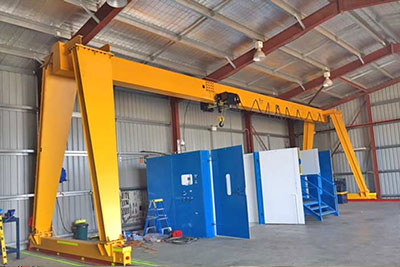
Single Girder Rail Gantry Cranes
The single girder rail gantry crane stands as a testament to simplicity meeting efficiency. This type of crane is characterized by a single horizontal beam (the girder) that supports the lifting mechanism, making it a versatile choice for a wide range of applications. The design simplicity translates to ease of maintenance, reduced structural weight, and cost-effectiveness.
In terms of applications, the single girder rail gantry crane shines in scenarios where precision and flexibility are paramount. Its ability to navigate confined spaces and tight corners makes it a go-to solution for workshops and facilities with limited operating space. Moreover, the single girder design facilitates faster installation, minimizing downtime during crane implementation.
Suitable Industries and Workshops
Industries that deal with the handling of light to medium loads find a reliable ally in the single girder rail gantry crane. Manufacturing workshops, assembly lines, and warehouses where the emphasis is on the efficient movement of components benefit greatly from the maneuverability and versatility offered by this crane.
The automotive industry, for instance, relies on single girder rail gantry cranes for tasks such as engine assembly, where precision and agility are essential. Similarly, in the electronics sector, where delicate components require careful handling, these cranes prove invaluable.
Focus on Light to Medium Load Handling
The single girder rail gantry crane's sweet spot lies in its ability to handle light to medium loads with utmost precision. From lifting raw materials in a manufacturing setting to positioning components on an assembly line, this crane ensures that every operation is executed smoothly.
Industries dealing with products that fall within the 1 to 20-ton range often find the single girder rail gantry crane to be the perfect solution. Its adaptability to varying load capacities makes it an asset in environments where production requirements fluctuate, providing a cost-effective and efficient material handling solution.
As we navigate the world of rail gantry cranes, the single girder variant emerges as a workhorse tailored for specific needs. In the next segment, we'll explore the prowess of double girder rail gantry cranes, shedding light on their applications in handling heavier loads and addressing the demands of more robust industrial settings.
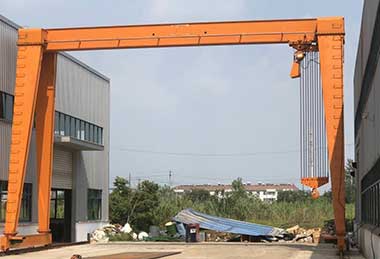
Box girder single girder rail gantry crane for sale 1 ton to 20 ton
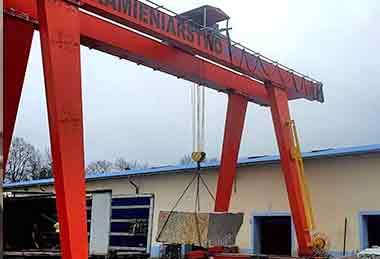
Double Girder Rail Gantry Cranes
Double girder rail gantry cranes epitomize strength and reliability, offering a robust solution for heavy-duty material handling tasks. Unlike their single girder counterparts, these cranes feature two horizontal beams (girders), providing enhanced stability and load-bearing capacity. The double girder design enables smoother operation, reduced deflection, and increased lifting heights, making it an ideal choice for demanding industrial environments.
One of the standout features of double girder rail gantry cranes is their superior lifting capacity. With the ability to handle loads ranging from 5 to 200 tons or more, these cranes are well-suited for industries where heavy materials or machinery need to be maneuvered with precision. The dual girder configuration also allows for the integration of auxiliary lifting mechanisms, such as hoists and trolleys, further enhancing their versatility and functionality.
In terms of benefits, double girder rail gantry cranes offer unparalleled performance and efficiency. Their sturdy construction ensures long-term durability and reliability, minimizing downtime and maintenance costs. Additionally, the double girder design provides increased headroom and hook height, allowing for greater flexibility in load positioning and movement.
Ideal Sectors and Facilities
Double girder rail gantry cranes find applications across a wide range of sectors and facilities where heavy loads and high precision are paramount. Industries such as steel manufacturing, shipbuilding, and aerospace rely on these cranes for lifting and transporting bulky materials and components.
In steel mills, for example, double girder rail gantry cranes play a crucial role in handling raw materials such as steel coils and ingots, as well as finished products like beams and plates. Their ability to withstand harsh operating conditions and extreme temperatures makes them indispensable in these environments.
Similarly, in shipyards, double girder rail gantry cranes are used for assembling and launching large vessels, requiring precision and stability during the lifting process. The robust construction of these cranes ensures safe and efficient handling of heavy ship components, such as hull sections and machinery.
Handling Heavy Loads with Precision
The hallmark of double girder rail gantry cranes lies in their ability to handle heavy loads with unparalleled precision. Whether lifting steel beams in a fabrication shop or maneuvering aircraft components in an aerospace facility, these cranes excel in delivering precise and controlled movements.
Advanced control systems, such as variable frequency drives and programmable logic controllers, further enhance the precision and efficiency of double girder rail gantry cranes. These systems allow for smooth acceleration and deceleration, precise load positioning, and automated operation, minimizing the risk of accidents and optimizing productivity.
In summary, double girder rail gantry cranes offer a robust and reliable solution for handling heavy loads in demanding industrial environments. With their superior lifting capacity, durability, and precision, these cranes are the backbone of material handling operations across a diverse range of sectors.
Industry-Specific Applications
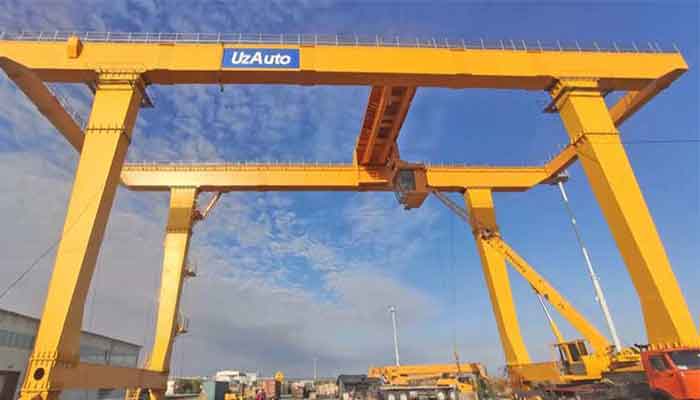
Automotive Manufacturing
Utilization in Assembly Lines
In the fast-paced world of automotive manufacturing, precision and efficiency are non-negotiable. This is where rail gantry cranes, specifically designed for the unique demands of assembly lines, take center stage. Within the realm of automotive manufacturing, rail gantry cranes play a crucial role in seamlessly orchestrating the assembly process.
These cranes are strategically positioned along assembly lines to lift and position various components with accuracy. From engines and chassis to intricate electronic systems, rail gantry cranes ensure that each component is precisely placed, contributing to the smooth progression of the assembly process. The ability to traverse horizontally along the rail system allows these cranes to cover the entire length of the assembly line, eliminating bottlenecks and optimizing workflow.
Handling Various Car Components
Automotive manufacturing involves a diverse range of components, each with its own weight and size specifications. Rail gantry cranes excel in handling this diversity, providing a versatile solution for lifting and positioning various car components. Whether it's the precise installation of heavy engines or the delicate placement of electronic modules, these cranes offer the adaptability required for the dynamic nature of automotive assembly.
From the heavy-duty lifting of chassis frames to the intricate maneuvering of small parts, rail gantry cranes in automotive manufacturing facilities are engineered to cater to the specific needs of the industry. This adaptability contributes to the overall efficiency of the assembly line, reducing assembly time and ensuring the seamless integration of components.
Tonnage and Capacity Insights
The automotive industry demands a careful balance between strength and precision, and rail gantry cranes are tailored to meet these requirements. Tonnage and capacity considerations play a crucial role in determining the effectiveness of these cranes in automotive manufacturing.
For heavy-duty tasks like lifting engine blocks or entire vehicle chassis, rail gantry cranes with higher tonnage capacities, ranging from 10 to 50 tons, are commonly employed. This ensures that the crane can handle the substantial weight of automotive components without compromising on precision.
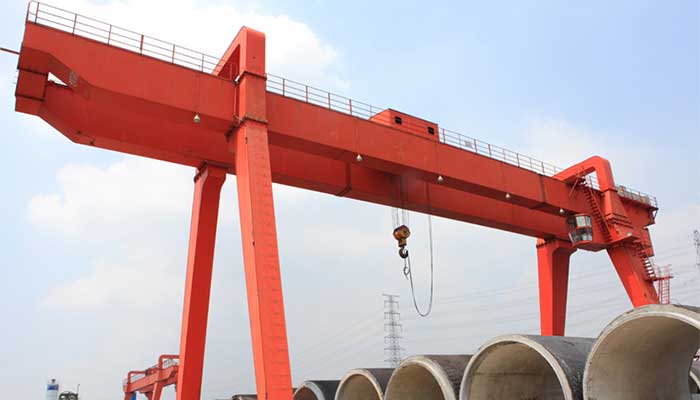
In contrast, for tasks that involve the manipulation of smaller components or intricate parts, rail gantry cranes with lower tonnage capacities, ranging from 1 to 10 tons, come into play. These cranes offer the finesse required for delicate operations while maintaining the efficiency demanded by the automotive assembly line.
In the dynamic world of automotive manufacturing, where precision and speed are paramount, rail gantry cranes prove to be invaluable partners. Their ability to handle diverse components, coupled with the flexibility to adapt to varying tonnages, positions them as a cornerstone in the quest for streamlined and efficient production processes.
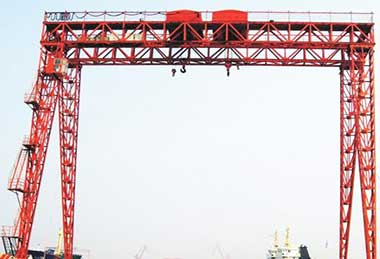
Ports and Shipping Yards
Container Handling Capabilities
At the heart of global trade, ports and shipping yards rely on the efficiency of material handling systems to keep the wheels of commerce turning. Rail gantry cranes play a pivotal role in these bustling environments, particularly in the seamless handling of containers. Containerization, a hallmark of modern shipping, demands precision and speed in moving standardized containers, and rail gantry cranes are well-equipped for the task.
The container handling capabilities of rail gantry cranes extend to loading and unloading containers from ships, stacking and destacking containers in storage yards, and transporting them to various points within the port. Their versatility ensures that they can handle containers of different sizes and weights, contributing to the efficient flow of goods in and out of the port.
Synchronization with Maritime Operations
Ports and shipping yards are intricate ecosystems where timing is everything. Rail gantry cranes are meticulously synchronized with maritime operations to ensure a harmonious flow of cargo. As ships arrive, these cranes swing into action, efficiently unloading containers from the vessels and placing them in designated areas for storage or further transportation.
The horizontal mobility along the rail system allows rail gantry cranes to cover extensive areas of the port, facilitating quick and precise movements. The synchronization with maritime operations, coupled with advanced control systems, minimizes turnaround times for ships and optimizes the overall efficiency of port operations.
Tonnage Considerations for Port Efficiency
Efficiency in port operations is closely tied to the tonnage considerations of rail gantry cranes. Ports handle a vast array of cargo, from lightweight commodities to heavy machinery, and rail gantry cranes must be tailored to accommodate this diversity.
For the efficient handling of standard shipping containers, rail gantry cranes with tonnage capacities in the range of 30 to 100 tons are commonly employed. These cranes are capable of lifting and moving containers with precision, ensuring a steady flow of cargo in and out of the port.
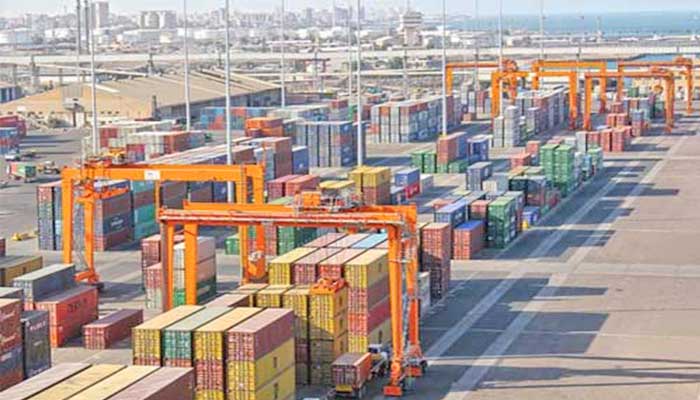
In cases where specialized heavy cargo, such as large machinery or oversized equipment, needs to be handled, rail gantry cranes with higher tonnage capacities, exceeding 100 tons, come into play. These cranes are designed to meet the demands of heavy and irregularly shaped loads, contributing to the versatility of port operations.
In conclusion, rail gantry cranes are the unsung heroes of ports and shipping yards, orchestrating the intricate dance of container movements with precision and efficiency. Their container handling capabilities, synchronization with maritime operations, and tonnage considerations are essential elements in maintaining the fluidity of global trade through these vital hubs.
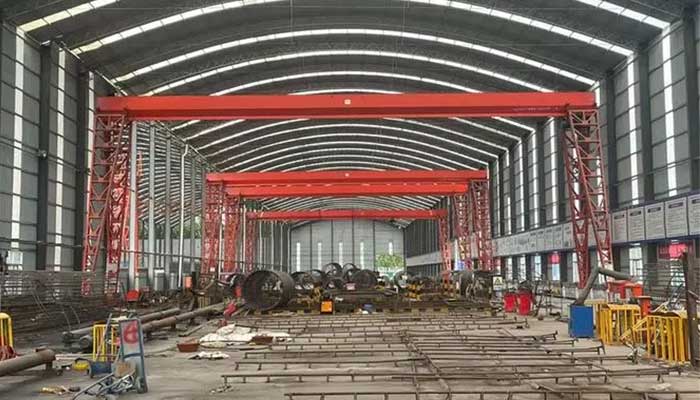
Warehousing and Logistics
Streamlining Storage and Retrieval
In the world of warehousing and logistics, where efficiency is synonymous with success, rail gantry cranes emerge as indispensable tools for streamlining the storage and retrieval processes. These cranes are strategically deployed to maximize the utilization of warehouse space, optimizing the vertical dimension for efficient storage.
Rail gantry cranes efficiently lift and transport goods to and from high storage racks with precision. Their ability to traverse horizontally along the rail system allows them to cover extensive areas of the warehouse, reaching even the furthest corners. This streamlined approach to storage and retrieval minimizes delays, reduces the risk of errors, and enhances overall warehouse productivity.
Handling Varied Packaging and Goods
Warehouses are hubs of diversity, handling a myriad of goods with varying sizes, shapes, and packaging. Rail gantry cranes, equipped with versatile lifting mechanisms, are designed to handle this diversity with ease. From palletized goods to irregularly shaped items, these cranes provide a flexible solution for the varied demands of warehousing and logistics.
The adaptability of rail gantry cranes extends to the handling of different packaging types, including boxes, crates, and containers. Their precision in grasping and moving goods ensures the safe and efficient handling of items with varying packaging specifications, contributing to the smooth flow of goods within the warehouse.

Tailored Solutions for Different Weight Classes
One of the key strengths of rail gantry cranes in warehousing and logistics lies in their ability to offer tailored solutions for different weight classes. Warehouses deal with goods ranging from lightweight products to heavy machinery, and rail gantry cranes are designed to cater to this spectrum.
For handling lighter loads or smaller items, rail gantry cranes with lower tonnage capacities, typically in the range of 1 to 10 tons, are employed. These cranes provide the precision and agility required for delicate operations, such as picking and placing individual items on shelves.
In contrast, for heavier items or bulk storage, rail gantry cranes with higher tonnage capacities, ranging from 10 to 50 tons or more, are utilized. These cranes ensure the efficient movement of substantial loads, contributing to the optimization of storage space and overall warehouse logistics.
In the dynamic landscape of warehousing and logistics, where every second counts, rail gantry cranes prove to be the linchpin in achieving operational excellence. Their role in streamlining storage and retrieval, handling diverse goods, and offering tailored solutions for different weight classes positions them as essential assets in the quest for efficient and effective warehouse management.
Advanced Features and Technologies
Automation and Remote Control
Enhanced Precision and Safety
The integration of automation and remote control technologies marks a paradigm shift in the capabilities of rail gantry cranes, ushering in a new era of enhanced precision and safety. Automated rail gantry cranes are equipped with sophisticated control systems that allow for precise and repeatable movements, minimizing the margin of error in material handling operations.
Automation ensures that each lift and movement is executed with the utmost accuracy, contributing to the overall efficiency of industrial processes. Remote control functionalities further enhance precision by allowing operators to control the crane from a safe distance, providing a clear line of sight for optimal load positioning and minimizing the risk of accidents.
Safety is paramount in industrial settings, and automated rail gantry cranes excel in this aspect. Advanced sensors and monitoring systems detect potential hazards, and automated safety protocols can swiftly intervene to prevent accidents. This integration of technology not only protects personnel but also safeguards valuable equipment and materials.
Real-time Monitoring of Loads
Real-time monitoring of loads is a game-changer in the realm of rail gantry cranes. Equipped with load sensors and monitoring systems, these cranes provide operators and supervisors with instant insights into the weight and status of the loads being handled.
This real-time monitoring capability enhances decision-making processes, allowing operators to adjust lifting parameters on the fly and ensuring that loads are handled within safe and efficient limits. It also contributes to preventive maintenance efforts, as any anomalies or deviations from normal operating conditions can be identified and addressed promptly.
In conclusion, the advanced features and technologies integrated into rail gantry cranes, such as automation, remote control, and real-time monitoring, represent a leap forward in the quest for precision, safety, and efficiency in material handling. As these cranes continue to evolve in tandem with the principles of Industry 4.0, they become not just tools but integral components of a smart and interconnected industrial landscape.
Safety Measures and Compliance
Emergency Shutdown Systems
In the realm of rail gantry cranes, safety is paramount, and the implementation of advanced safety measures takes center stage. Emergency shutdown systems stand as a critical feature, providing a failsafe mechanism to swiftly halt crane operations in the face of unforeseen circumstances.
These systems are designed to respond to a range of emergencies, from equipment malfunctions to the detection of potential hazards in the operational environment. In the event of an emergency, the emergency shutdown system is activated, bringing the crane to an immediate stop and preventing any further movement. This rapid response capability significantly reduces the risk of accidents and safeguards both personnel and valuable assets.
Load Monitoring and Prevention of Overloading
Load monitoring technology represents a pivotal advancement in ensuring the safe and efficient operation of rail gantry cranes. Load sensors and monitoring systems continuously assess the weight and distribution of the load being lifted, providing real-time data to crane operators.
The prevention of overloading is a key focus of this technology. In scenarios where the load approaches or exceeds the crane's rated capacity, the system triggers alarms or automatically engages safety measures to prevent overloading. This proactive approach not only protects the crane from structural strain but also mitigates the risk of accidents and ensures the safety of personnel working in the vicinity.
Compliance with Industry Standards
Rail gantry cranes operate within diverse industrial sectors, each governed by specific safety standards and regulations. Adhering to these standards is non-negotiable, and modern rail gantry cranes are engineered with a commitment to compliance.
These cranes are designed and manufactured in accordance with industry-specific standards, ensuring that they meet or exceed the safety requirements set forth by regulatory bodies. Compliance covers a spectrum of factors, including structural integrity, electrical safety, and operational protocols. The integration of safety features is aligned with these standards, providing a comprehensive approach to ensuring the well-being of both personnel and the industrial environment.
In addition to meeting regulatory requirements, rail gantry cranes often undergo rigorous testing and certification processes to validate their compliance. This commitment to adherence to industry standards not only instills confidence in the reliability of these cranes but also reflects a dedication to creating a safe and secure working environment.
In conclusion, the incorporation of safety measures and compliance features in rail gantry cranes goes beyond mere regulatory adherence; it represents a commitment to the well-being of personnel, the protection of valuable assets, and the cultivation of a safety-first culture within the industrial landscape. As these cranes continue to evolve, safety remains at the forefront, driving advancements that contribute to accident prevention and overall operational excellence.
Real-World Examples Across Industries
Success Stories in Automotive Manufacturing
In the automotive manufacturing sector, the implementation of rail gantry cranes has led to remarkable success stories, revolutionizing assembly line processes. A prominent example is a leading automotive manufacturer that integrated automated rail gantry cranes into its assembly line. The result was a significant reduction in assembly time, with precise and efficient handling of various car components.
These rail gantry cranes were strategically positioned to lift and place components such as engines, chassis, and delicate electronics with unparalleled accuracy. The automated systems ensured a seamless workflow, contributing to increased production output and maintaining the high quality standards demanded by the automotive industry.
The success of this implementation goes beyond efficiency; it exemplifies how rail gantry cranes can play a pivotal role in enhancing the overall competitiveness of automotive manufacturing, demonstrating the transformative impact of advanced material handling solutions.
Port Efficiency Achievements
In the realm of ports and shipping yards, rail gantry cranes have played a central role in achieving unprecedented efficiency and throughput. A major international port, facing challenges in container handling and ship turnaround times, invested in state-of-the-art rail gantry cranes.
The implementation of these cranes optimized container movements, reducing loading and unloading times significantly. The horizontal mobility of the rail gantry cranes, coupled with advanced automation features, allowed for precise positioning of containers and streamlined cargo flow. This not only improved port efficiency but also contributed to a substantial increase in the overall capacity of the port, accommodating the growing demands of global trade.
The port's success story highlights how rail gantry cranes are instrumental in addressing the complex logistics of containerized cargo, showcasing their adaptability and efficiency in meeting the evolving needs of maritime operations.
Warehousing Solutions Tailored to Specific Needs
In the dynamic landscape of warehousing and logistics, a case study from a multinational logistics company illustrates the tailoring of rail gantry crane solutions to specific needs. Faced with the challenge of efficiently handling a diverse range of goods with varying weights and sizes, the company opted for a customized rail gantry crane system.
The rail gantry cranes were equipped with advanced load monitoring technology, allowing for precise handling of goods ranging from small, fragile items to heavy machinery. The automation features ensured efficient storage and retrieval processes, contributing to a significant reduction in operational costs and a boost in overall warehouse productivity.
This case study exemplifies how rail gantry cranes, when tailored to the specific needs of warehousing and logistics, become strategic assets in optimizing material handling operations. The ability to adapt to diverse goods and offer customized solutions underscores the versatility and effectiveness of rail gantry cranes in the logistics landscape.
In conclusion, these real-world case studies showcase the transformative impact of rail gantry cranes across different industries. From automotive manufacturing to port operations and warehousing, these success stories highlight how these cranes go beyond mere material handling tools, becoming integral components in achieving operational excellence and meeting the challenges of diverse industrial landscapes.
Summarizing the Versatility and Impact of Rail Gantry Cranes
In the journey through the world of rail gantry cranes, it becomes evident that these mechanical marvels are not merely pieces of equipment but rather integral components that shape the landscape of diverse industries. From automotive manufacturing to port operations and warehousing, rail gantry cranes showcase unparalleled versatility and impact.
Rail gantry cranes, with their ability to handle various loads, adapt to specific industry needs, and integrate advanced technologies, stand as catalysts for efficiency and precision. They streamline material handling processes, optimize workflows, and contribute to the overall success of industrial operations. Whether it's the heavy lifting prowess of double girder cranes or the agility of rubber-tired variants, each type finds its unique place in the tapestry of industry-specific challenges.
As we stand at the crossroads of technological advancement, the future of rail gantry cranes holds exciting possibilities. The integration of artificial intelligence for predictive maintenance, further advancements in automation and remote control capabilities, and the evolution of smart, interconnected systems are on the horizon.
Industry experts anticipate a continued focus on sustainability, with the development of eco-friendly and energy-efficient rail gantry cranes. The seamless integration of rail gantry cranes into the broader framework of Industry 4.0 will likely usher in an era where these machines not only perform material handling tasks but actively contribute to data-driven decision-making processes.
In conclusion, the journey through rail gantry cranes is a testament to their evolution from traditional lifting machines to sophisticated, intelligent systems. The impact they have made across industries is significant, and the future promises even more exciting developments as these cranes continue to shape the landscape of material handling technologies.
Related Products

Latest project
150 Ton Overhead Crane Installation Feedback – Paraguay Case
QDX 150 ton overhead crane in action in Paraguay. Installation photos, video, and client feedback show performance, safety, and heavy-lifting efficiency.
Free consultation to Confirm Parameters & Specifications and Get
Latest Crane Price & Crane Rate.
- Types of overhead cranes : _______?
- Optional: Overhead travelling crane, goliath gantry crane,Slewing jib crane, Single girder or double girder crane,small portable crane or kbk crane, etc.
- Capacity of overhead crane: _______?
- Optional: 0.25ton, 0.5 ton, 1 ton, 2 ton, 3ton, 5 ton, 10 ton,15ton, 20ton, 25 ton, 30ton,35ton, up to 550ton, etc.
- Crane span & lifting height : _______?
- Crane travelling length : _____?
- Control of overhead crane:_______?
- Optional: pendant/ remote/cabin control
- Voltage supply of overhead crane:_____?
- Eg,: 380V50/60HZ,3Phase or others,etc.
- Application/usage of crane:_______?
- Eg,: Steel mill, ,injection mold, cement,stone, concrete,granite, general manufacturing, etc.
Just leave a message via the contact form and our hoist and crane engineer will contact you with in 24working hours.
Get In Touch
